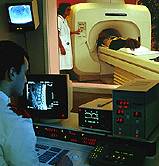
TUESDAY, April 23 (HealthDay News) — Atrophy of a key brain area may become a new biomarker to predict the onset of multiple sclerosis, researchers say. If so, that would add to established criteria such as the presence of brain lesions to diagnose the progressive, incurable disorder.
Using special MRI images, scientists from three continents found that the thalamus — which acts as a “relay center” for nervous-system signals — had atrophied in nearly 43 percent of patients who had suffered an initial neurological episode that often comes before a multiple sclerosis (MS) diagnosis.
“The telling appearance of lesions, which is a hallmark of the disease, is only part of the pathology,” said study author Dr. Robert Zivadinov, director of the Buffalo Neuroimaging Analysis Center at the University of Buffalo, in New York. “Our finding is more related to [initiating] clinical trials, to using thalamic volume as a new biomarker for testing and treatment, and to increasing awareness among investigators that this disease is more than just about lesions.”
The study was published online April 23 in the journal Radiology.
Believed to be an autoimmune disorder, MS results in lesions on the brain and spinal cord that disrupt nerve signals to various parts of the body. Symptoms, which can come and go, include numbness, tingling, vision disturbances, problems walking, dizziness, and bowel and bladder problems.
More than 2 million people live with MS worldwide, according to the Multiple Sclerosis Foundation.
For the new research, Zivadinov and his team used contrast-enhanced MRI images to evaluate more than 200 patients who had suffered an initial, short-term neurological episode known as clinically isolated syndrome. About 85 percent people who have one of these episodes will go on to be diagnosed with MS within two years, and the diagnosis also relies on a second attack and the detection of new or enlarging lesions using MRI.
The study performed follow-up scans on patients at six months, one year and two years. It found that decreases in the size of the thalamus were independently associated with the development of clinically definite MS, along with an increased volume in another part of the brain known as the lateral ventricles.
The findings suggest shrinkage of the thalamus could become a biomarker for MS because it’s detectable at a very early stage, Zivadinov said.
“What’s triggering this and how it’s connected with the thalamus should be explored,” he said, “but … that this research is indicating that the thalamus is profoundly affected so early on leads us to focus more on those regions of the brain.”
Dr. Gary Birnbaum, director of the MS Treatment and Research Center at the Minneapolis Clinic of Neurology, said he thinks the study highlights the concept that MS is a combination of inflammatory and degenerative processes.
But Birnbaum, who was not involved with the study, said measuring the size of the thalamus on special MRI scans is more complex than what is possible with traditional scans. He said this new finding needs to be confirmed before being useful in clinical MS diagnoses.
“The [thalamic] measurement … may become a very valuable tool in terms of measuring the effectiveness of new therapies,” he said. “But in terms of the day-to-day practice of a neurologist trying to figure out if a person has MS, at this particular time it’s perhaps not as valuable as measuring new lesions.”
More information
To learn more about MS, visit the National Multiple Sclerosis Society.

